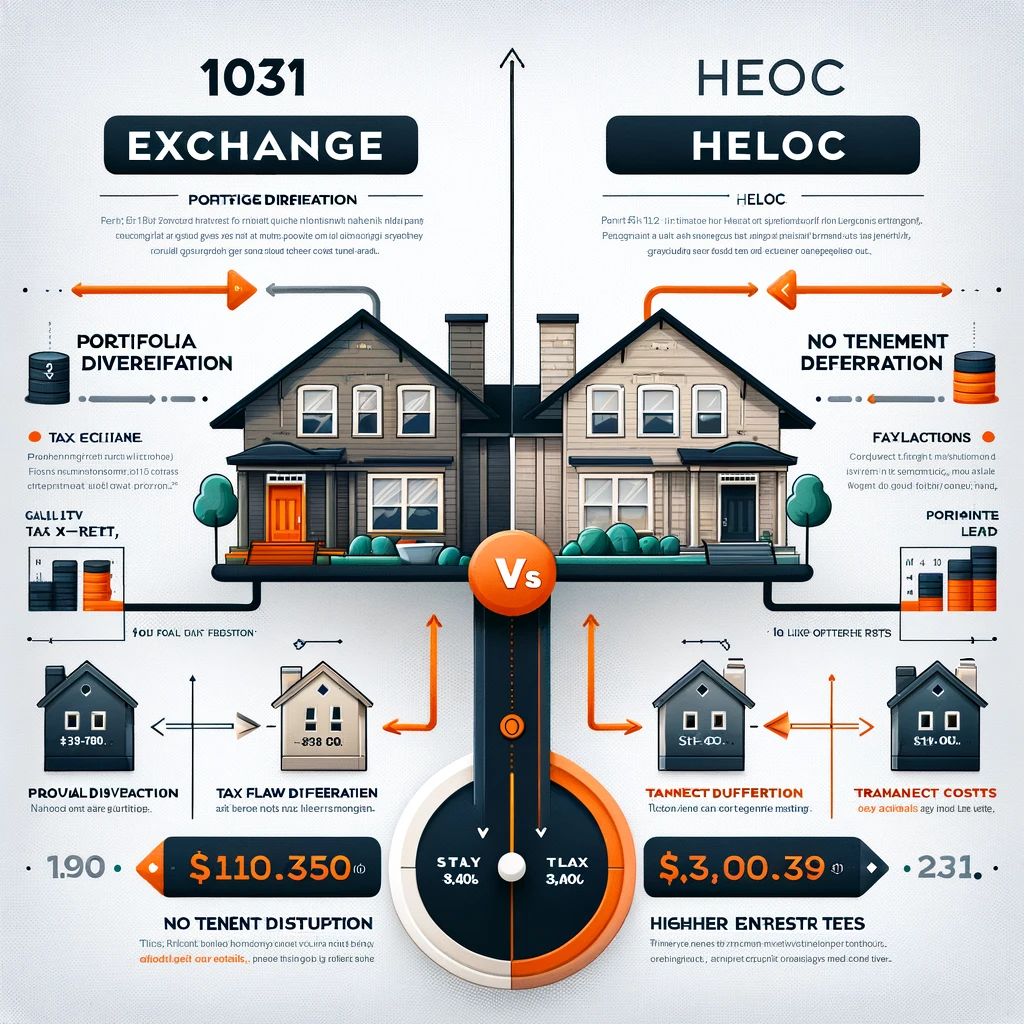
Leveraging Equity in Your Investment Property: 1031 Exchange vs. HELOC
As a real estate investor, one of your greatest assets is the equity built into your properties. Tapping into this equity can be a powerful strategy for growing your portfolio or maximizing returns. But what’s the best way to do it? Today, we’ll explore two primary methods: leveraging a 1031 Exchange or using a Home Equity Line of Credit (HELOC). Each has its own advantages, disadvantages, and financial implications. Let’s dive into the details so you can make the best decision for your investment strategy.
Option 1: Selling via a 1031 Exchange
A 1031 Exchange allows you to defer capital gains taxes by reinvesting the proceeds from selling a property into one or more “like-kind” properties. For an investor with significant equity, this can be a game-changer.
How It Works
- Sell your current property.
- Use the proceeds to purchase two (or more) new investment properties of equal or greater value.
Advantages
- Portfolio Diversification: By acquiring multiple properties, you spread your risk and expand your income streams.
- Tax Deferral: The 1031 Exchange helps you defer capital gains taxes, preserving more of your capital for reinvestment.
- Increased Equity Utilization: Your equity now works across multiple properties instead of being tied up in one.
Disadvantages
- Transaction Costs: Selling involves agent fees, closing costs, and other transaction expenses.
- Preparation Hassles: You may need to renovate or refresh the property to attract buyers, which adds to your costs and time investment.
- Tenant Disruption: Tenants may need to vacate, interrupting rental income and creating potential legal or logistical challenges.
- Timing Constraints: The IRS imposes strict timelines on identifying and closing on replacement properties, adding pressure to the process.
Option 2: Using a HELOC to Fund a Down Payment
A Home Equity Line of Credit (HELOC) lets you borrow against the equity in your property. This line of credit can be used to fund the down payment for a new investment property without selling your existing asset.
How It Works
- Take out a HELOC based on the equity in your current property.
- Use the borrowed funds as a down payment on another investment property.
Advantages
- Less Disruption: There’s no need to sell your property, relocate tenants, or pause rental income.
- Immediate Access: HELOC funds are accessible quickly and can be used regardless of the property’s current occupancy.
- Flexibility: HELOCs are revolving lines of credit, meaning you can borrow, repay, and borrow again as needed.
- Lower Interest Costs: HELOCs typically use simple interest, which can save money compared to the compounding interest of traditional loans.
Disadvantages
- Higher Interest Rates: HELOCs often come with variable rates, which can increase over time.
- Cash Flow Impact: Monthly payments on the HELOC may reduce your overall cash flow, although typically less than the costs associated with selling a property.
Comparing the Two Options
| Aspect | 1031 Exchange | HELOC |
|---|---|---|
| Tax Benefits | Defers capital gains taxes | None |
| Cost | High transaction and preparation costs | Lower upfront costs |
| Impact on Cash Flow | Minimal, as new properties generate income | Some impact due to HELOC payments |
| Operational Disruption | Requires tenant relocation and property prep | No disruption; property remains operational |
| Flexibility | Limited to reinvestment timelines | Highly flexible and reusable line of credit |
Key Takeaways for Investors
Both options allow you to unlock the equity in your investment property, but the best choice depends on your goals and circumstances.
- If your priority is expanding your portfolio and diversifying risk, a 1031 Exchange might be the way to go. Just be prepared for the costs and operational disruptions.
- If you prefer speed, flexibility, and minimal disruption, a HELOC offers a convenient alternative with potentially lower costs over time.
Final Thoughts
Understanding the financial impact of these options is crucial. While a 1031 Exchange might help you scale your portfolio, a HELOC could provide a more cost-effective and streamlined way to grow your investments.
As always, it’s important to model your specific financial situation to make an informed decision. By comparing cash flow, total costs, and long-term returns, you can confidently choose the strategy that aligns with your investment goals.
Are you ready to explore these strategies further? Let’s run the numbers and find the best path forward for your portfolio.
Pro Tip
Consult with a tax professional and financial advisor before making significant investment decisions. They can provide personalized guidance tailored to your specific financial landscape.
Disclaimer: This analysis is for informational purposes only and should not be considered financial advice. Always conduct thorough due diligence and consult with qualified financial professionals.
